In October of 2019, the Geological Society of America (GSA) invited me to present a talk at their Annual Meeting, being held in Phoenix, AZ. The title was An Incomprehensible Cosmic Impact at the Mid Pleistocene Transition; Searching for the Missing Crater Using Australasian Tektite Suborbital Analysis and Carolina Bays' Major Axes Triangulation. Quite a mouthful. The abstract (also included here,) and a PDF file of the slides deck with transcript, can be found at the GSA Site (LINK). The content is summarized on our website http://mptimpact.org .
Australasian (AA) tektites are distal ejecta of a cosmic impact into terrestrial sediments 788.1 ± 2.8 ka. Protracted explorations within the strewn field, as preferred by consensus opinion, have yielded neither an astrobleme nor a proximal imprint. In 3 lesser strewn fields correlated with progenitor astroblemes, tektites are strewn asymmetrically and their total masses and minimum loft distances scale with projectile kinetic energy (KE) partitioning yield. Pursuing an a priori astrobleme location within the uniquely expansive AA strewn field ignores such findings. Absent identification of proximal ejecta in the strewn field, workers are now inferring that indochinite tektites are proximal, dismissing their known devolatilization, weightless vacuum quench and their carefully derived re-entry speeds, ≥ 80% of Earth escape. A defendable guess 40 years ago, but promoting an a priori astrobleme in Indochina is now impeding progress.
Ironically, a cosmic link to the Carolina bays' genesis is considered soundly falsified by the same absence of a correlated astrobleme. We have measured ~50,000 of these shallow, oriented, ovoid basins, located around an annulus focused on Saginaw Bay, Michigan. We posit the ovoid planforms to be surficial manifestations of cavitation voids within an incomprehensible geophysical mass flow of volatiles and entrained target clastics. Unifying both missing astroblemes, we propose an incomprehensible cosmic event on a hemisphere diametrically opposed to the AA distal tektite strewn field. We invoke a highly oblique, perhaps tangential, hypervelocity projectile ricocheting off the Earth’s limb along an extended footprint. Sub-horizontal shock to thick MIS 20 ice sheet overburden triggered endogenic comminution, as stored pressure potential within the substrate was released by phase change of pore water to steam, provisioning fluidized medial ejecta outflow for Carolina bay emplacement. Shocked ice plume expansion augmented tektite velocities, and dissipated significant partitioned KE, preventing another Chicxulub-style global conflagration. The KE partitioning process conspired with intervening ice age transgressions to dislocate proximal ejecta and obfuscate the cosmic signature.
AA tektite Suborbital Analysis with appropriate dynamical accounting supports our putative antipodal Saginaw impact site, as does a recent EIGEN 6C4 gravity field assessment. The hypothesis would be falsified if 26Al/10Be burial dating analysis of terraces under Carolina bays disallows deposition 788 ka.
The AGU invited me to present our latest research on the Carolina bays, Australasian Tektite Strewn Field, and the enigmatic Mid Pleistocene Transition Impact. The abstract is available on the AGU website HERE, and that page has a link to the ePoster pdf file.

A session talk was delivered at the 2017 GSA Southeastern Section meeting in Richmond, VA in March of 2017, entitled THE CAROLINA BAYS OF RIDGE SPRING, SC . Here, we explored the expansive remnant Cretaceous drainage divide running from Augusta, GA to Columbia, NC. It is dotted with many perfectly-sculpted baySouth planform Carolina bays. Given that the drainage divide’s terrace is actively being eroded from all sides, there are numerous example of bays in various stages of headward erosion removal, demonstrating the concept of “Valley Head Basins”.
A session talk and a poster were presented by me at the 2015 GSA Annual Meeting in Baltimore, MD. In my talk, I discussed evidence of significant erosion across the entire family of Carolina bays. Such evidence help support an age of 800,000 years for the formative event. Entitled “They Don’t Build 'Em Like They Used To; Examining Lidar Of Modified Costal Terrace Surfaces Shows The Carolina Bay Landform To Be Robust When Threatened With Alteration By Gradualistic Processes”, and a PDF version of the talk is available from the GSA via the link HERE. The poster shared the the new LiDAR available from Virginia, and how that re-emphasizes the uniqueness of the Carolina bays present across the “upland Gravels” of Virginia on the surviving Midlothian/Bon Air terrace: “Lidar Elevation Data Provides New Insight Into The Bon Air Gravel And Attendant Carolina Bays”. The abstract and a link to the poster PDF is available form the GSA site linked HERE, and displayed in a smaller image below.
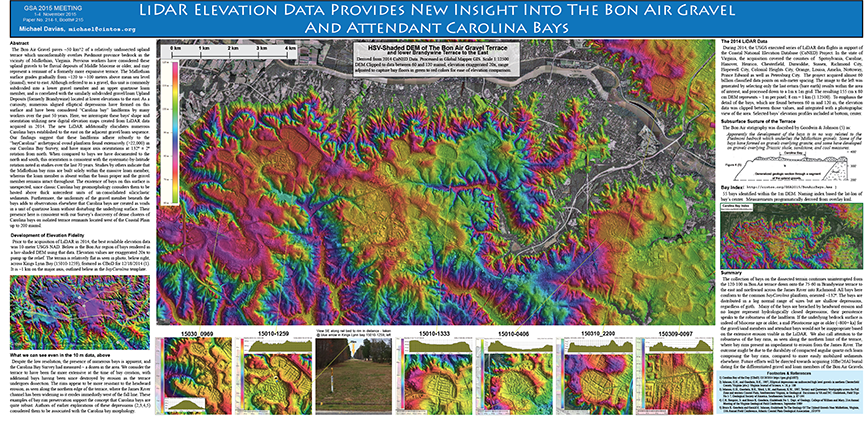
A session talk was presented at the 2015 GSA North Central Section Meeting in Madison, WI. Here, we premiered our new temporal estimate, 786 ka. , coincident with the Mid - Pleistocene Transition. Entitled A Tale of Two Craters, we address the most damming falsification of a Carolina bay - cosmic impact hypotheses: the missing crater. Turns out there is another missing crater, and it is a whopper. The MPT Impact was likely the most powerful extraterrestrial impact since the K-T boundary event. Suborbital ejecta tracing of the expo-atmospheric and near-escape velocity tektite geomorphology firmly places the Saginaw Bay impact site as a probable location for the event, and the forensic character of the Michigan Red Bed sands match the fingerprints found in analyzing the Australasian Tektites.
A session talk and a poster were presented by me at the 2013 GSA Annual Meeting in Denver, CO. The talk attempted to review the derivation of the six bay planforms currently being utilized to measure Carolina bays in the Survey. Entitled, “A Proposed Taxonomy For Carolina Bay Circumferential Rim Planforms; Findings Of Robust Adherence To Distinctive Archetypes Is Supported By Lidar-Derived Digital Elevation Maps”, the link connects to the GSA abstract page, which hosts a link to an annotated PDF version of the slide deck. The poster, entitled Carolina Bays And Aeolian Dunes: Playing Nice In The Sandbox?, reviews the juxtaposition of aeolian dunes and Carolina bays in several settings. LiDAR imagery was used extensively in both the Poster and the Talk to support the discussions.
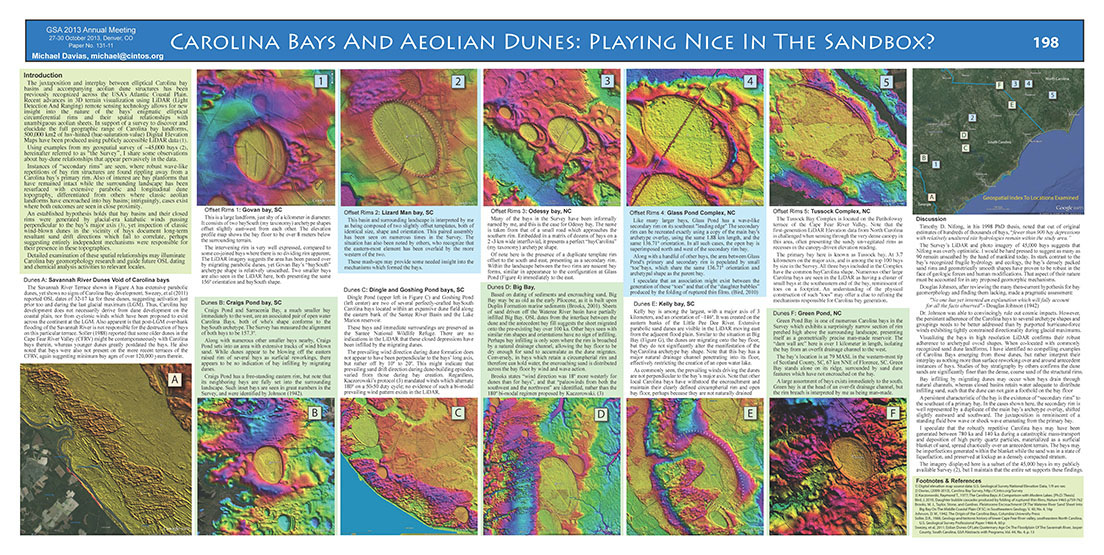
A poster was presented at the 2012 GSA Annual Meeting in Charlotte, NC. There we explored the Cape Fear River Valley and the terraces within, in an attempt to revisit David Soller’s observations regarding Carolina Bay ages. Entitled, Where The Bays Are: A Temporal Tale Of Carolina Bay Geomorphology As Told In Lidar By The Wando And Socastee Terraces, the link connects to the GSA abstract page, which links to an on-line version of the poster.
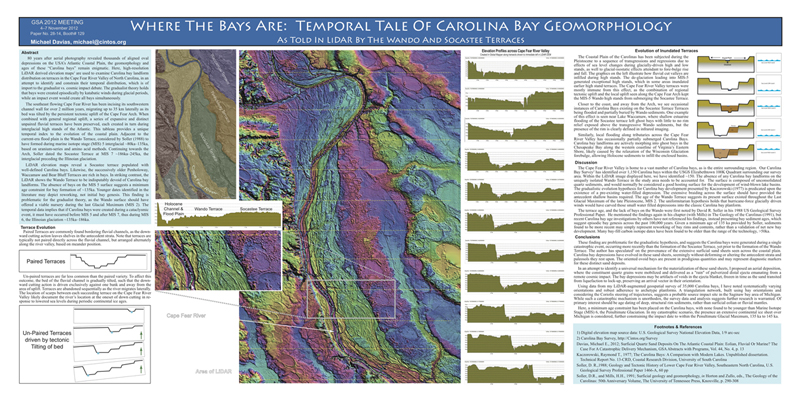
The 2012 GSA Southeastern Section Meeting allowed me the opportunity to present an oral talk on the subject SURFICIAL QUARTZ SAND DEPOSITS ON THE ATLANTIC COASTAL PLAIN: EOLIAN, FLUVIAL OR MARINE? THE CASE FOR A CATASTROPHIC DELIVERY MECHANISM. Link is to the GSA abstract page, which contains a link to the lecture slides and notes.
I presented an oral talk at the 2012 GSA Northeastern Section Meeting in Hartford, entitled LIDAR-DERIVED DIGITAL ELEVATION MAPS OF MARYLAND, DELAWARE AND NEW JERSEY USED TO IDENTIFY CAROLINA BAY LANDFORMS. Link is to the GSA abstract page, which contains a link to the lecture slides and notes.
We presented a poster at the 2011 GSA Annual Meeting in Minneapolis. The poster content, seen below, is also available as a PDF for download. I presented a TALK on the Survey and its use of LiDAR & Google Earth. A PDF of the deck is available HERE.
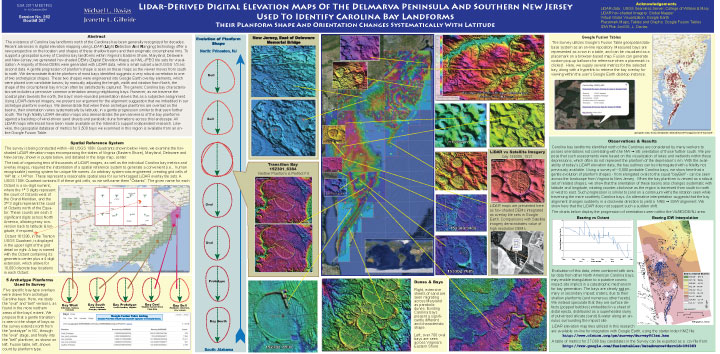
We presented a poster at the 2011 Southeastern Section GSA Meeting in Wilmington. The poster content, seen below, is also available as a PDF for download.
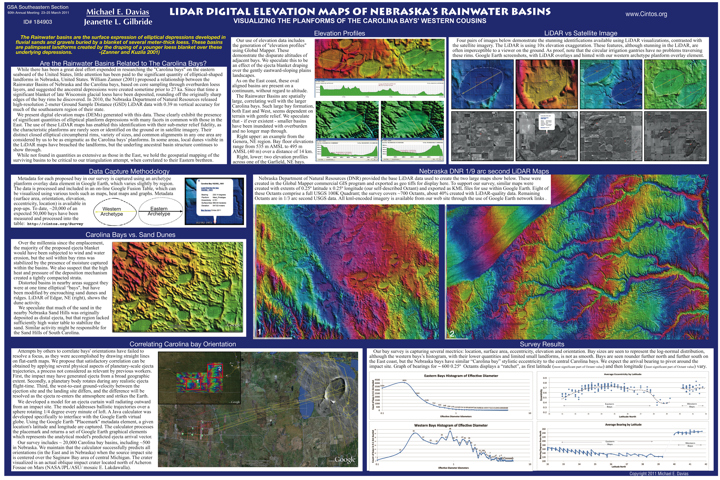
We presented a poster at the 2010 GSA Meeting in Denver. The poster content, seen below, is also available in a booklet PDF file.

We also had the opportunity to give an oral presentation on our use of LiDAR in this research at the 2010 GSA Meeting in Denver. A PDF of the presentation is available for download from HERE, or can be viewed as web pages HERE.
We presented a poster (PP31D-1387 Geomorphology Of Possible Younger Dryas Boundary Impact Structure) at the December 2009 AGU Fall Meeting in San Francisco which detailed some of our concepts as they pertain to the Carolina bays and their role in identifying a possible ice shield impact crater. A PDF file of the submission in slide presentation form is available for download HERE. Links are available to two videos on You Tube (Part 1& Part 2) in which we discuss the poster at the AGU meeting. Please note that since the meeting, we have refined the impact location to the Saginaw Bay area of Michigan. The small version below is linked to a higher resolution pdf.

Two videos filmed by George Howard are available on YouTube. In these videos, our AGU poster is referenced to discuss the distal ejecta conjecture and the Carolina bay inferred alignments. Click on the images below to watch the video. Note that since the AGU Fall Meeting we are now proposing an impact in the Saginaw area vs the Lake Michigan basin, as discussed in the 2nd video.


YouTube videos by George Howard

Geological Research by Cintos is licensed under a Creative Commons Attribution-NonCommercial-ShareAlike 3.0 Unported License.
Based on a work at Cintos.org.
Permissions beyond the scope of this license may be available at http://cintos.org/about.html.



